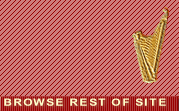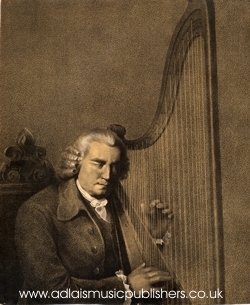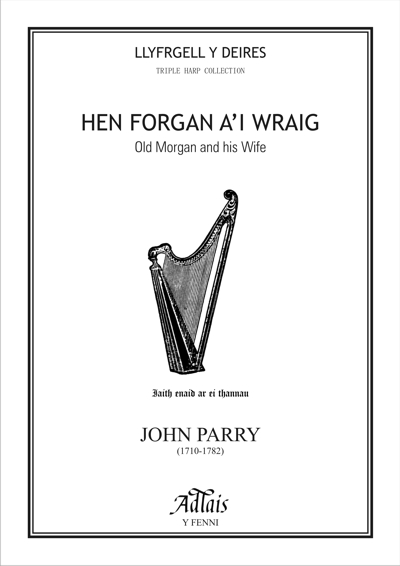 |
|||
| |
of Harp Music |
| © 2004-2025 ADLAIS |
| Hen
Forgan a'i wraig Old
Morgan and his Wife John Parry (PARRI DDALL 1710-1782) |
return to previous page |
 |
Work: | Single work for solo harp |
| Catalogue No: | Adlais 085 | |
| ISMN: | 979-0-57032-122-3 | |
| Edition: | 2007, A4 stapled | |
| Duration: | 2' 50" minutes | |
| Suitable for: | Grade 3 - 4 Triple Harp | |
| Price:: | £4.00 Go to shop | |
| HEN FORGAN A’I WRAIG Y GŴR Mae arna’i eisiau gwybod, Siân, A roist ti fwyd i’r moch? Ac oni roddaist, mae’n llawn bryd, Mae’n mynd am ddeg o’r gloch. Y WRAIG Wel dyna ti yn dechrau’th rinc, Yn dinc, yn dinc, o hyd; Mae gwrando ar dy gwrnad gâs, Ymron â’m gyrru o’r byd. Y GŴR Pe ba’et yn mynd o’r byd rhyw awr, Mi gawn i fawr ymwared Y WRAIG Ond nid a’i ddim i’th blesio di Ychwaith, er maint dy ddwned Y GŴR O! pe bai’n digwydd iti fynd Y WRAIG Ca’it wedyn weld fy ngholled Y GŴR Taw, Siân, taw Siân, O taw, mae’n bryd Y WRAIG Taw di, taw di’r Hen Forgan GYDA’I GILYDD HITHAU Mi dawa’i i, rwy’n dweud iti YNTAU Taw, taw, taw, taw, taw Pan leicia’i fy hunan Y GŴR Y mae dy sŵn yn union fel Cacynen mewn bys coch A dechrau’r cwbl oedd i’m ddweud A roist ti fwyd i’r moch?” Y WRAIG Y mae dy rygniad diflas di, A’th rwngc, yn ganmil gwaeth Yn holi o hyd, o hyd, “Sawl pwys A wnaeth y corddiad llaeth?” Y GŴR Ti wyddost Siân, pan ddaw y rhent, Mai’r menyn yw ein swcwr Y WRAIG Wel, porthwch chwithau’r gwartheg, syr Fel delo’n well eu cyflwr: Y GŴR Yr ydwy’i’n gwneuthur hynny,Siân Y WRAIG Wel, gwna, a thaw â’th ddwndwr Y GŴR Taw, Siân, taw Siân, taw, gwarchod ni! Mae’n bryd it gau dy hopran Y WRAIG Mi dawa’i, rwy’n dweud i ti, Pan leici’i ‘r hen Forgan |
OLD MORGAN AND HIS WIFE |
 Bewigged and powdered, John Parry was a Master of the
High Baroque. Born in about 1710, and almost certainly on the Cefn Amwlch
estate at Bryn Cynan on the Lleyn Peninsula, he was blind from birth.
His first patrons were the Griffiths family, owners of the estate, and
they provided the young blind boy with the harp which was to give him
the means of making a livelihood. This was a Welsh triple harp, and John
Parry played it in the traditional manner, resting it on his left shoulder,
the left hand playing the treble, and the right hand playing the bass.
Bewigged and powdered, John Parry was a Master of the
High Baroque. Born in about 1710, and almost certainly on the Cefn Amwlch
estate at Bryn Cynan on the Lleyn Peninsula, he was blind from birth.
His first patrons were the Griffiths family, owners of the estate, and
they provided the young blind boy with the harp which was to give him
the means of making a livelihood. This was a Welsh triple harp, and John
Parry played it in the traditional manner, resting it on his left shoulder,
the left hand playing the treble, and the right hand playing the bass.
During the eighteenth-century, the only possible way of making a professional career as a harpist was to find oneself a wealthy patron, and by the late 1730s John Parry had gained the patronage of the family in whose employ he was to remain for the rest of his life. This was the family of Sir Watkin Williams Wynn, whose family seat was Wynnstay, near Ruabon. As a Member of Parliament, Sir Watkin kept a house in London as well, and he would have taken his retinue, which included his harpist, from one house to another with him. Thus John Parry spent a great deal of time in London and mixed in the cultural and artistic circles of his day. His first publication was his ‘Antient Welsh Airs by the Bards of Wales’ (1742), and such was the pride of his patron Sir Watkin Williams Wynn in the preeminence of his harpist that he subscribed to no fewer than ten copies of the book.
John Parry’s concert career does not seem to have been much hampered by his blindness. There are accounts of his concerts in London, Cambridge, Oxford, Leeds and Dublin, and on 27 February and 1 March 1741 he played Handel’s Concerto in B flat at Hickford’s Great Room in Brewer Street, Soho.
In 1710 the harpist William Powel died. He was the harpist who, fourteen years before, had given the first performance of Handel’s Concerto, and who, at the time of his death was harpist to Frederick, Prince of Wales. “Race to London like a greyhound after a hare, and there is no doubt but that you will obtain the prize you so richly deserve”, urged his friend Richard Morris. “Refuse not your due honour when it be offered unto you”, he continued. But to no avail. There is no record of John Parry’s ever having hankered after a Royal Appointment, or being offered one despite his distinction.
In 1757, it was John Parry’s playing which inspired the poet Thomas Gray to finish his Ode ‘The Bard’ and no doubt it is his noble playing which is commemorated in the lines “And with a master’s hand and prophet’s fire/ Struck the deep sorrows of his lyre”. It is for his ‘Lessons’ or Sonatas for the Harp (Adlais Catalogue no. 39) that John Parry is best remembered today. These were published along with a second collection of ‘Welsh, English and Scotch Airs with new Variations’ in 1761. He was admitted to the élite circle of the Royal Society of Musicians in 1763, and he knew many distinguished people like Sir Joshua Reynolds, the painter, and Sir David Garrick, the actor – rather to the resentment of some of his Welsh friends who considered him haughty, disdainful and cold. He published another collection of ‘Antient Airs’ in 1781. This one was called ‘British Harmony’, and dedicated to Sir Watkin Williams Wynn II, son of his previous patron.
John Parry died on 7 October 1782, and the engraving* reproduced in the ‘Gentleman’s Magazine’ after his death is eloquent enough testimony to the esteem in which he was held, as an influential and greatly respected musical figure.
*reproduced on the cover and inside pages of Adlais’s facsimile edition of the Four Lessons/Sonatas.
A portrait painted by his son, William Parry, once hung in Lady Llanover’s home (www.ladyllanover.org.uk) and the triple harp which he played in 1755 has been reproduced by Christopher Barlow (www.barlowharps.demon.co. uk) , and is now owned and played by Ann Griffiths.
Two other composer-harpists named John Parry are represented in the Adlais Catalogue, viz. John Parry (Bardd Alaw) (1776-1851), and his son John Orlando Parry (1810-1879).
© Ann Griffiths 2005

